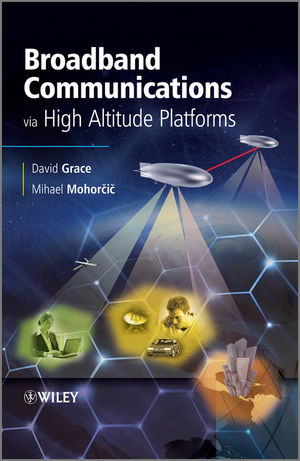Broadband Communications via High Altitude PlatformsISBN: 978-0-470-69445-9
Hardcover
398 pages
October 2010
 |
||||||
1.1. Introduction.
1.2. History.
1.3. Wireless communications in a HAP environment.
1.4. Candidate standards for provision of services and applications from HAPs.
1.5. Overview of past and present HAP related projects, trials and development plans.
1.6. References.
2. AERONAUTICS AND ENERGETICS.
2.1. Operating environment and related challenges.
2.2. Types of airborne vehicles used for HAPs.
2.3. Power subsystem alternatives.
2.4. Flight / altitude control.
2.5. Typical characteristics of HAP aircraft and airships.
2.6. References.
3. OPERATING SCENARIOS AND REFERENCE ARCHITECTURES.
3.1. Operating scenarios.
3.2. Antenna requirements and related challenges.
3.3. System and network architecture of HAP-based communication systems.
3.4. References.
4. APPLICATIONS AND BUSINESS MODELLING.
4.1. Introduction.
4.2. Applications and services.
4.3. Business Model Introduction.
4.4. Service Provider Centric Models.
4.5. HAP Operator Centric Model.
4.6. Risk Assessment.
4.7. References.
5. FUTURE DEVELOPMENT OF HAPs AND HAP-BASED APPLICATIONS.
5.1. Trends in aeronautical development.
5.2. HAP roadmaps for different types of applications.
5.3. Telecommunication missions.
5.4. References.
6. HAP SYSTEM OPERATING ENVIRONMENT.
6.1. Operating environment and related limitations.
6.2. Propagation channel modelling.
6.3. HAP RF propagation channel modelling.
6.4. Conclusion.
6.5. References.
7. FSO IN HAP-BASED COMMUNICATION SYSTEMS.
7.1. Applicability of FSO technology to HAP networks.
7.2. Physical layer aspects for FSO links in HAP networks.
7.3. Free space optics for optical transport networks.
7.4. References.
8. ADVANCED COMMUNICATION TECHNIQUES AS ENABLERS FOR HAP-BASED COMMUNICATION SYSTEMS.
8.1. Modern wireless system design concepts.
8.2. Diversity techniques.
8.3. Multiple input multiple output systems.
8.4. Adaptive coding modulation schemes.
8.5. Advanced radio resource management techniques.
8.6. References.
9. MULTIPLE HAP NETWORKS.
9.1. Why multiple HAP constellations?
9.2. Multiple HAP constellation planning.
9.3. User Antenna Pointing Error in Multiple HAP Systems.
9.4. Two Ring Constellation Design for Multiple HAP Systems.
9.5. Constraints of Two-ring Constellation Designs.
9.6. References.
10. NETWORKING IMPLICATIONS OF USING MULTIPLE HAP CONSTELLATIONS.
10.1. Network protocols.
10.2. Mobility management in HAP-based communication systems.
10.3. Mobility and Backhaul Load Reduction Techniques.
10.4. References.
Index.



